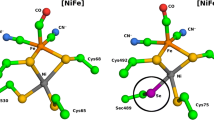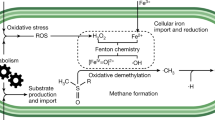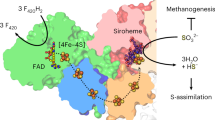Abstract
Certain anaerobic microorganisms evolved a mechanism to use H2 as a reductant in their energy metabolisms. For these purposes, the microorganisms developed H2-activating enzymes, which are aspirational catalysts in a sustainable hydrogen economy. In the case of the hydrogenotrophic pathway performed by methanogenic archaea, 8e− are extracted from 4H2 and used as reducing equivalents to convert CO2 into CH4. Under standard cultivation conditions, these archaea express [NiFe]-hydrogenases, which are Ni-dependent and Fe-dependent enzymes and heterolytically cleave H2 into 2H+ and 2e−, the latter being supplied into the central metabolism. Under Ni-limiting conditions, F420-reducing [NiFe]-hydrogenases are downregulated and their functions are predominantly taken over by an upregulated [Fe]-hydrogenase. Unique in biology, this Fe-dependent hydrogenase cleaves H2 and directly transfers H− to an imidazolium-containing substrate. [Fe]-hydrogenase activates H2 at an Fe cofactor ligated by two CO molecules, an acyl group, a pyridinol N atom and a cysteine thiolate as the central constituent. This Fe centre has inspired chemists to not only design synthetic mimics to catalytically cleave H2 in solution but also for incorporation into apo-[Fe]-hydrogenase to give semi-synthetic proteins. This Perspective describes the enzymes involved in hydrogenotrophic methanogenesis, with a focus on those performing the reduction steps. Of these, we describe [Fe]-hydrogenases in detail and cover recent progress in their synthetic modelling.
This is a preview of subscription content, access via your institution
Access options
Access Nature and 54 other Nature Portfolio journals
Get Nature+, our best-value online-access subscription
$29.99 / 30 days
cancel any time
Subscribe to this journal
Receive 12 digital issues and online access to articles
$119.00 per year
only $9.92 per issue
Buy this article
- Purchase on Springer Link
- Instant access to full article PDF
Prices may be subject to local taxes which are calculated during checkout





Similar content being viewed by others
References
Thauer, R. K., Kaster, A.-K., Seedorf, H., Buckel, W. & Hedderich, R. Methanogenic archaea: ecologically relevant differences in energy conservation. Nat. Rev. Microbiol. 6, 579–591 (2008).
Thauer, R. K. et al. Hydrogenases from methanogenic archaea, nickel, a novel cofactor, and H2 storage. Annu. Rev. Biochem. 79, 507–536 (2010).
Mayumi, D. et al. Methane production from coal by a single methanogen. Science 354, 222–225 (2016).
Lang, K. et al. New mode of energy metabolism in the seventh order of methanogens as revealed by comparative genome analysis of “Candidatus Methanoplasma termitum”. Appl. Environ. Microbiol. 81, 1338–1352 (2015).
Welte, C. & Deppenmeier, U. Bioenergetics and anaerobic respiratory chains of aceticlastic methanogens. Biochim. Biophys. Acta 1837, 1130–1147 (2014).
Shima, S. & Ermler, U. Structure and function of [Fe]-hydrogenase and its iron–guanylylpyridinol (FeGP) cofactor. Eur. J. Inorg. Chem. 2011, 963–972 (2011).
Zirngibl, C. et al. H2-forming methylenetetrahydromethanopterin dehydrogenase, a novel type of hydrogenase without iron–sulfur clusters in methanogenic archaea. Eur. J. Biochem. 208, 511–520 (1992).
Wagner, T., Ermler, U. & Shima, S. The methanogenic CO2 reducing-and-fixing enzyme is bifunctional and contains 46 [4Fe-4S] clusters. Science 354, 114–117 (2016).
Bertram, P. A. et al. Formylmethanofuran dehydrogenases from methanogenic Archaea. Substrate specificity, EPR properties and reversible inactivation by cyanide of the molybdenum or tungsten iron-sulfur proteins. Eur. J. Biochem. 220, 477–484 (1994).
Schmitz, R. A., Albracht, S. P. & Thauer, R. K. A molybdenum and a tungsten isoenzyme of formylmethanofuran dehydrogenase in the thermophilic archaeon Methanobacterium wolfei. Eur. J. Biochem. 209, 1013–1018 (1992).
Bertram, P. A. & Thauer, R. K. Thermodynamics of the formylmethanofuran dehydrogenase reaction in Methanobacterium thermoautotrophicum. Eur. J. Biochem. 226, 811–818 (1994).
Niks, D. & Hille, R. Molybdenum- and tungsten-containing formate dehydrogenases and formylmethanofuran dehydrogenases: Structure, mechanism, and cofactor insertion. Protein Sci. 28, 111–122 (2019).
DiMarco, A. A., Bobik, T. A. & Wolfe, R. S. Unusual coenzymes of methanogenesis. Annu. Rev. Biochem. 59, 355–394 (1990).
Donnelly, M. I. & Wolfe, R. S. The role of formylmethanofuran: tetrahydromethanopterin formyltransferase in methanogenesis from carbon dioxide. J. Biol. Chem. 261, 16653–16659 (1986).
Ceh, K. et al. Structural basis of the hydride transfer mechanism in F420-dependent methylenetetrahydromethanopterin dehydrogenase. Biochemistry 48, 10098–10105 (2009).
Shima, S. et al. Structure of coenzyme F420 dependent methylenetetrahydromethanopterin reductase from two methanogenic archaea. J. Mol. Biol. 300, 935–950 (2000).
Vitt, S. et al. The F420-reducing [NiFe]-hydrogenase complex from Methanothermobacter marburgensis, the first X-ray structure of a group 3 family member. J. Mol. Biol. 426, 2813–2826 (2014).
Afting, C., Hochheimer, A. & Thauer, R. K. Function of H2-forming methylenetetrahydromethanopterin dehydrogenase from Methanobacterium thermoautotrophicum in coenzyme F420 reduction with H2. Arch. Microbiol. 169, 206–210 (1998).
Stojanowic, A., Mander, G. J., Duin, E. C. & Hedderich, R. Physiological role of the F420-non-reducing hydrogenase (Mvh) from Methanothermobacter marburgensis. Arch. Microbiol. 180, 194–203 (2003).
Thauer, R. K. Methyl (alkyl)-coenzyme M reductases: nickel F430-containing enzymes involved in anaerobic methane formation and in anaerobic oxidation of methane or of short chain alkanes. Biochemistry 58, 5198–5220 (2019).
Gottschalk, G. & Thauer, R. K. The Na+-translocating methyltransferase complex from methanogenic archaea. Biochim. Biophys. Acta 1505, 28–36 (2001).
Wagner, T., Ermler, U. & Shima, S. MtrA of the sodium ion pumping methyltransferase binds cobalamin in a unique mode. Sci. Rep. 6, 28226 (2016).
Wagner, T., Koch, J., Ermler, U. & Shima, S. Methanogenic heterodisulfide reductase (HdrABC-MvhAGD) uses two noncubane [4Fe-4S] clusters for reduction. Science 357, 699–703 (2017).
Pelmenschikov, V., Blomberg, M. R. A., Siegbahn, P. E. M. & Crabtree, R. H. A mechanism from quantum chemical studies for methane formation in methanogenesis. J. Am. Chem. Soc. 124, 4039–4049 (2002).
Wongnate, T. et al. The radical mechanism of biological methane synthesis by methyl-coenzyme M reductase. Science 352, 953–958 (2016).
Kaster, A. K., Moll, J., Parey, K. & Thauer, R. K. Coupling of ferredoxin and heterodisulfide reduction via electron bifurcation in hydrogenotrophic methanogenic archaea. Proc. Natl Acad. Sci. USA 108, 2981–2986 (2011).
Setzke, E., Hedderich, R., Heiden, S. & Thauer, R. K. H2:heterodisulfide oxidoreductase complex from Methanobacterium thermoautotrophicum: composition and properties. Eur. J. Biochem. 220, 139–148 (1994).
Watanabe, T. et al. The bacterial [Fe]-hydrogenase paralog HmdII uses tetrahydrofolate derivatives as substrates. Angew. Chem. Int. Ed. 58, 3506–3510 (2019).
Hiromoto, T. et al. The crystal structure of C176A mutated [Fe]-hydrogenase suggests an acyl-iron ligation in the active site iron complex. FEBS Lett. 583, 585–590 (2009).
Shima, S. et al. The crystal structure of [Fe]-hydrogenase reveals the geometry of the active site. Science 321, 572–575 (2008).
Huang, G. F. et al. The atomic-resolution crystal structure of activated [Fe]-hydrogenase. Nat. Catal. 2, 537–543 (2019).
Shima, S. et al. Evidence for acyl–iron ligation in the active site of [Fe]-hydrogenase provided by mass spectrometry and infrared spectroscopy. Dalton Trans. 41, 767–771 (2012).
Shima, S. et al. Reconstitution of [Fe]-hydrogenase using model complexes. Nat. Chem. 7, 995–1002 (2015).
Lyon, E. J. et al. UV-A/blue-light inactivation of the ‘metal-free’ hydrogenase (Hmd) from methanogenic archaea. The enzyme contains functional iron after all. Eur. J. Biochem. 271, 195–204 (2004).
Wagner, T., Huang, G. F., Ermler, U. & Shima, S. How [Fe]-hydrogenase from Methanothermobacter is protected against light and oxidative stress. Angew. Chem. Int. Ed. 130, 15276–15279 (2018).
Hiromoto, T., Warkentin, E., Moll, J., Ermler, U. & Shima, S. The crystal structure of an [Fe]-hydrogenase–substrate complex reveals the framework for H2 activation. Angew. Chem. Int. Ed. 48, 6457–6460 (2009).
Tamura, H. et al. Crystal structures of [Fe]-hydrogenase in complex with inhibitory isocyanides: implications for the H2-activation site. Angew. Chem. Int. Ed. 52, 9656–9659 (2013).
Dey, A. Density functional theory calculations on the mononuclear non-heme iron active site of Hmd hydrogenase: role of the internal ligands in tuning external ligand binding and driving H2 heterolysis. J. Am. Chem. Soc. 132, 13892–13901 (2010).
Berkessel, A. Activation of dihydrogen without transition metals. Curr. Opin. Chem. Biol. 5, 486–490 (2001).
Berkessel, A. & Thauer, R. K. On the mechanism of catalysis by a metal-free hydrogenase from methanogenic archaea: enzymatic transformation of H2 without a metal and its analogy to the chemistry of alkanes in superacidic solution. Angew. Chem. Int. Ed. 34, 2247–2250 (1995).
Shomura, Y. et al. Structural basis of the redox switches in the NAD+-reducing soluble [NiFe]-hydrogenase. Science 357, 928–932 (2017).
Mills, D. J., Vitt, S., Strauss, M., Shima, S. & Vonck, J. De novo modeling of the F420-reducing [NiFe]-hydrogenase from a methanogenic archaeon by cryo-electron microscopy. Elife 2, e00218 (2013).
Lubitz, W., Ogata, H., Rudiger, O. & Reijerse, E. Hydrogenases. Chem. Rev. 114, 4081–4148 (2014).
Evans, R. M. et al. Mechanism of hydrogen activation by [NiFe] hydrogenases. Nat. Chem. Biol. 12, 46–50 (2016).
Berggren, G. et al. Biomimetic assembly and activation of [FeFe]-hydrogenases. Nature 499, 66–69 (2013).
Ogata, H., Nishikawa, K. & Lubitz, W. Hydrogens detected by subatomic resolution protein crystallography in a [NiFe] hydrogenase. Nature 520, 571–574 (2015).
Ogata, H. et al. Hydride bridge in [NiFe]-hydrogenase observed by nuclear resonance vibrational spectroscopy. Nat. Commun. 6, 7890 (2015).
Winkler, M. et al. Accumulating the hydride state in the catalytic cycle of [FeFe]-hydrogenases. Nat. Commun. 8, 16115 (2017).
Reijerse, E. J. et al. Direct observation of an iron-bound terminal hydride in [FeFe]-hydrogenase by nuclear resonance vibrational spectroscopy. J. Am. Chem. Soc. 139, 4306–4309 (2017).
Huang, G. et al. Dioxygen sensitivity of [Fe]-hydrogenase in the presence of reducing substrates. Angew. Chem. Int. Ed. 57, 4917–4920 (2018).
Korbas, M. et al. The iron–sulfur cluster-free hydrogenase (Hmd) is a metalloenzyme with a novel iron binding motif. J. Biol. Chem. 281, 30804–30813 (2006).
Lyon, E. J. et al. Carbon monoxide as an intrinsic ligand to iron in the active site of the iron–sulfur-cluster-free hydrogenase H2-forming methylenetetrahydromethanopterin dehydrogenase as revealed by infrared spectroscopy. J. Am. Chem. Soc. 126, 14239–14248 (2004).
Shima, S., Lyon, E. J., Thauer, R. K., Mienert, B. & Bill, E. Mössbauer studies of the iron–sulfur cluster-free hydrogenase: the electronic state of the mononuclear Fe active site. J. Am. Chem. Soc. 127, 10430–10435 (2005).
Guo, Y. S. et al. Characterization of the Fe site in iron–sulfur cluster-free hydrogenase (Hmd) and of a model compound via nuclear resonance vibrational spectroscopy (NRVS). Inorg. Chem. 47, 3969–3977 (2008).
Chen, D., Scopelliti, R. & Hu, X. [Fe]-hydrogenase models featuring acylmethylpyridinyl ligands. Angew. Chem. Int. Ed. 49, 7512–7515 (2010).
Chen, D., Ahrens-Botzong, A., Schünemann, V., Scopelliti, R. & Hu, X. Synthesis and characterization of a series of model complexes of the active site of [Fe]-hydrogenase (Hmd). Inorg. Chem. 50, 5249–5257 (2011).
Chen, D., Scopelliti, R. & Hu, X. Synthesis and reactivity of iron acyl complexes modeling the active site of [Fe]-hydrogenase. J. Am. Chem. Soc. 132, 928–929 (2010).
Chen, D., Scopelliti, R. & Hu, X. A five-coordinate iron center in the active site of [Fe]-hydrogenase: hints from a model study. Angew. Chem. Int. Ed. 50, 5671–5673 (2011).
Chen, D., Scopelliti, R. & Hu, X. Reversible protonation of a thiolate ligand in an [Fe]-hydrogenase model complex. Angew. Chem. Int. Ed. 51, 1919–1921 (2012).
Hu, B., Chen, D. & Hu, X. A pyridinol acyl cofactor in the active site of [Fe]-hydrogenase evidenced by the reactivity of model complexes. Chem. Eur. J. 18, 11528–11530 (2012).
Obrist, B. V. et al. An iron carbonyl pyridonate complex related to the active site of the [Fe]-hydrogenase (Hmd). Inorg. Chem. 48, 3514–3516 (2009).
Schultz, K. M., Chen, D. & Hu, X. [Fe]-hydrogenase and models that contain iron–acyl ligation. Chem. Asian J. 8, 1068–1075 (2013).
Xu, T. et al. A functional model of [Fe]-hydrogenase. J. Am. Chem. Soc. 138, 3270–3273 (2016).
Liu, T. B. et al. Analysis of a pentacoordinate iron dicarbonyl as synthetic analogue of the Hmd or mono-iron hydrogenase active site. Chem. Eur. J. 16, 3083–3089 (2010).
Royer, A. M., Rauchfuss, T. B. & Gray, D. L. Oxidative addition of thioesters to iron(0): active-site models for Hmd, nature’s third hydrogenase. Organometallics 28, 3618–3620 (2009).
Royer, A. M., Rauchfuss, T. B. & Wilson, S. R. Coordination chemistry of a model for the GP cofactor in the Hmd hydrogenase: hydrogen-bonding and hydrogen-transfer catalysis. Inorg. Chem. 47, 395–397 (2008).
Royer, A. M., Salomone-Stagni, M., Rauchfuss, T. B. & Meyer-Klaucke, W. Iron acyl thiolato carbonyls: structural models for the active site of the [Fe]-hydrogenase (Hmd). J. Am. Chem. Soc. 132, 16997–17003 (2010).
Turrell, P. J., Wright, J. A., Peck, J. N. T., Oganesyan, V. S. & Pickett, C. J. The third hydrogenase: a ferracyclic carbamoyl with close structural analogy to the active site of Hmd. Angew. Chem. Int. Ed. 49, 7508–7511 (2010).
Wang, X. et al. The iron centre of the cluster-free hydrogenase (Hmd): low-spin Fe(II) or low-spin Fe(0)? Chem. Commun. 30, 3555–3557 (2008).
Durgaprasad, G., Xie, Z.-L. & Rose, M. J. Iron hydride detection and intramolecular hydride transfer in a synthetic model of mono-iron hydrogenase with a CNS chelate. Inorg. Chem. 55, 386–389 (2016).
Kerns, S. A., Magtaan, A.-C., Vong, P. R. & Rose, M. J. Functional hydride transfer by a thiolate-containing model of mono-iron hydrogenase featuring an anthracene scaffold. Angew. Chem. Int. Ed. 57, 2855–2858 (2018).
Manes, T. A. & Rose, M. J. Rigid scaffolds for the design of molecular catalysts and biomimetic active sites: a case study of anthracene-based ligands for modeling mono-iron hydrogenase (Hmd). Coord. Chem. Rev. 353, 295–308 (2017).
Muthiah, K. A. T. et al. Mononuclear iron(II) dicarbonyls derived from NNS ligands — structural models related to a “pre-acyl” active site of mono-iron (Hmd) hydrogenase. Eur. J. Inorg. Chem. 2015, 1675–1691 (2015).
Seo, J., Manes, T. A. & Rose, M. J. Structural and functional synthetic model of mono-iron hydrogenase featuring an anthracene scaffold. Nat. Chem. 9, 552–557 (2017).
Xie, Z.-L., Durgaprasad, G., Ali, A. K. & Rose, M. J. Substitution reactions of iron(II) carbamoyl–thioether complexes related to mono-iron hydrogenase. Dalton Trans. 46, 10814–10829 (2017).
Xie, Z.-L., Pennington, D. L., Boucher, D. G., Lo, J. & Rose, M. J. Effects of thiolate ligation in monoiron hydrogenase (Hmd): stability of the {Fe(CO)2}2+ core with NNS ligands. Inorg. Chem. 57, 10028–10039 (2018).
Song, L.-C. et al. Synthesis, structural characterization, and some properties of 2-acylmethyl-6-ester group-difunctionalized pyridine-containing iron complexes related to the active site of [Fe]-hydrogenase. Dalton Trans. 43, 8062–8071 (2014).
von der Höh, A. & Berkessel, A. Insight into the mechanism of dihydrogen heterolysis at cyclopentadienone iron complexes and subsequent C=X hydrogenation. ChemCatChem 3, 861–867 (2011).
Casey, C. P. & Guan, H. An efficient and chemoselective iron catalyst for the hydrogenation of ketones. J. Am. Chem. Soc. 129, 5816–5817 (2007).
Barik, C. K., Ganguly, R., Li, Y. & Leong, W. K. Structural mimics of the [Fe]-hydrogenase: a complete set for group VIII metals. Inorg. Chem. 57, 7113–7120 (2018).
Pan, H.-J. et al. A catalytically active [Mn]-hydrogenase incorporating a non-native metal cofactor. Nat. Chem. 11, 669–675 (2019).
Acknowledgements
This work was supported by grants from the Max Planck Society (to S.S., T.W. and U.E.) and the Deutsche Forschungsgemeinschaft (Iron-Sulfur for Life: SH 87/1-1, to S.S.).
Author information
Authors and Affiliations
Contributions
S.S. contributed to writing a draft and editing of the manuscript. G.H. contributed to drawing the figures. All authors contributed to discussing, writing and reviewing the manuscript before submission.
Corresponding author
Ethics declarations
Competing interests
The authors declare no competing interests.
Additional information
Publisher’s note
Springer Nature remains neutral with regard to jurisdictional claims in published maps and institutional affiliations.
Rights and permissions
About this article
Cite this article
Huang, G., Wagner, T., Ermler, U. et al. Methanogenesis involves direct hydride transfer from H2 to an organic substrate. Nat Rev Chem 4, 213–221 (2020). https://doi.org/10.1038/s41570-020-0167-2
Accepted:
Published:
Issue Date:
DOI: https://doi.org/10.1038/s41570-020-0167-2
This article is cited by
-
A personal account on 25 years of scientific literature on [FeFe]-hydrogenase
JBIC Journal of Biological Inorganic Chemistry (2023)
-
Non-contact biomimetic mechanism for selective hydrogenation of nitroaromatics on heterogeneous metal nanocatalysts
Science China Chemistry (2022)
-
Effects of cofD gene knock-out on the methanogenesis of Methanobrevibacter ruminantium
AMB Express (2021)
-
Induced volatolomics of pathologies
Nature Reviews Chemistry (2021)



